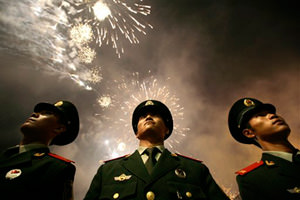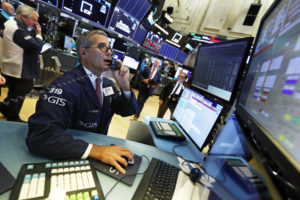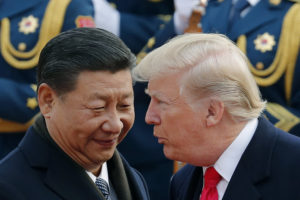The China Superpower Hoax
How is a country with a lower per capita income than Kazakhstan, one of the worst environmental records of any major nation and a dictatorship, besides, hailed by so many as the next global superpower?How is a country with a lower per capita income than Kazakhstan hailed by so many as the next global superpower?
China must have the best public relations maestros in the world. How else would a country with a lower per capita income than Iran, Mexico and Kazakhstan, one of the worst environmental records of any major nation, endemic corruption, jails stuffed with dissenters, and a dictatorship, besides, be hailed by so many as the next global superpower?
Certainly China is big — 1.3 billion people big, a fifth of the global population. As Forbes’ columnist John Lee has written, China has long been the place for the world’s biggest anything: the Great Wall, the 2008 Olympics, Tiananmen Square, the South China Mall in Dongguan, dams, consumption of cement and production of automobiles; most recently, China even had the world’s biggest traffic jam — an incredible 60 miles long — which lasted a month and during which drivers were stuck in their cars for days at a time.
The world has never see anything like mega-nations the size of China (or India for that matter), and no one even knows if populations of this magnitude ultimately are sustainable. China’s voracious need to supply its population and avoid the social explosions that have plagued its history has made it one of the world’s largest consumers of natural resources, especially timber and energy, extracted from places like Africa, Southeast Asia and South America. With such large appetites, China has the ability to drive global markets, and, consequently, has become the new frontier where “get rich quick” investors and Western businesses go panning for gold by speculating in some hot Chinese start-up.
Unfortunately, the hype ignores a starker reality — that China is barely holding it together. Contrarian voices like Hu Ping, the chief editor of Beijing Spring, a pro-human rights and democracy journal, try to humanize the conventional wisdom of economic statistics and facts that obscure reality. “With China portrayed in the news every day as an economic and political powerhouse, the rest of the world, at least those parts that treasure freedom and peace, should pay attention to the real China,” says Hu.
The Paradox of China
To understand the “real” China, it is necessary to see it through the double lens of its paradoxical condition as both a major economy and a still-developing country. China is filled with contradictions and serious challenges. When I visited China in August and September of 2008, after the Olympics, the country that I saw, whether in Shanghai, Beijing or the rural areas, was a long, long way from being a global leader in any meaningful sense. Two hundred million people out of a working population of nearly 800 million are migrants, chafing at their lowly status and rotten wages. Inequality is rampant. Returning from the rural areas — where the vast majority of Chinese still live — to cities is like a form of time travel, moving from feudal conditions where plowing is still done by water buffalo to a land of impressively jutting skyscrapers. Corruption is epidemic, whether in banks, the legal system or the political leadership at national, provincial and local levels, causing an estimated annual economic loss of approximately 15 percent of GDP, according to economist Hu Angang.
Even China’s much-touted economic power has been misunderstood. Recently it was announced around the world that China had surpassed Japan to become the second-largest national economy. But compared to the United States and Europe, China is still an economic mini-me. Europe’s gross domestic product is $17.5 trillion, according to the latest IMF figures, while the U.S. figure is $14.8 trillion and China’s is $5.4 trillion (by Europe, I mean the EU 27 plus Norway, Switzerland and Iceland).
Beyond economic output, more than three-fifths of China’s overall exports and nearly all its high-tech exports are made by non-Chinese, foreign companies. Foreign companies take advantage of low Chinese wages to reprocess imports of semi-manufactured goods that are then shipped to Europe and the U.S. China remains, in essence, a subcontractor to the West, says Will Hutton, British political analyst and author of an influential book on China, “The Writing on the Wall.” Despite China’s export success, there are few great Chinese brands or companies. China needs to build them, says Hutton, but doing that in a one-party authoritarian state, where the party second-guesses business strategy for ideological and political ends, is impossible.”
Because of China’s climate of corruption and authoritarian secrecy, even the volume of industrial output has been questioned. Some doubt China’s numbers and official reports. Investment guru James Chanos, who rose to prominence when he predicted the Enron meltdown (and pocketed a billion dollars shorting Enron stock), is shorting China now.
Says Chanos, “China is cooking its books. State-run companies are buying fleets of cars and storing them in parking lots and warehouses” to pump up state-mandated production figures. As evidence of this, experts point out that while car sales have been rising by a huge 20 percent per month, auto fuel usage seems to be rising by only 3-5 percent per month. Chanos also says China is plagued by an ominously growing real estate bubble in high-rise buildings, offices and condos. Much of China’s high growth originally came from decades-long heavy investment in infrastructure, but increasingly it has been coming from construction. Chanos estimates that 50 percent to 60 percent of China’s GDP now comes from alarming levels of overbuilding, virtually none of which is affordable to the average Chinese. “This is not affordable housing for the middle class; this is high-end condos in major urban areas and high-end office buildings, which no one is buying,” says Chanos.China is on this “treadmill to hell,” he says, because so much of its GDP growth comes from construction which can’t be sustained. If China were to slow down the construction industry, its GDP growth would go negative very quickly.
“That’s not going to happen, because in China people are rewarded at almost every level of government for making their economic growth numbers. The easiest way to do that is put up another building. They’re really hooked on this sort of heroin of real estate development to keep the numbers going,” Chanos says.
Sino enthusiasts are betting that China’s rulers, whom they see as having been competent stewards of a growing economy for decades, have the means to slowly let the air out of the bubble and avert disaster. But with entire building complexes — urban forests of office and condo high-rises — standing empty in China, Chanos and others are predicting a housing market crash like the one that occurred in the United States.
Walking an Environmental Tightrope Without a Net
The only thing cloudier than China’s economic model is the sky over its major cities, so choked with smog that some days you can’t see the high-rises a few blocks away. During the run-up to the 2008 Olympics in Beijing, many were concerned that athletes wouldn’t be able to breathe the foul air. To try to clear the air, the government instituted an odd-even auto policy, i.e. cars with license plates ending in an even number could drive one day, odd numbers the next. People in Beijing told me that the skies had not been so clear in decades (and they were greatly chagrined when the authorities eventually reverted to the previous laissez-faire policy, resulting in unprecedented traffic jams that make India’s look tame by comparison).
Four hundred thousand Chinese die every year of respiratory diseases caused by pollution. About 500 million rural Chinese — equivalent to the population of the entire European Union — still do not have access to safe drinking water. Acid rain, caused by sulfur dioxide emissions that belch from smokestacks of power plants, is endemic, with the state-run China Daily reporting that in Guangdong province — China’s most prosperous region, and also its most industrialized — 53 percent of total rainfall in 2008 was acid rain.
Food scares, such as industrial toxins mixed into milk powder, pet food and cough syrup, have been frequent, and there have been instances of exported toys bearing lead paint and drywall containing highly toxic sulfur compounds that made brand-new homes in the U.S. and elsewhere unlivable.
These consumer dangers are additional manifestations of the amoral, corrupt, robber-baron business practices that have been unleashed in China. The 2008 earthquakes in western Sichuan province, which resulted in the collapse of more than 7,000 schoolrooms and thousands of deaths among schoolchildren, disproportionately impacted the poor who lived in areas where corruption had resulted in shoddy construction practices. The suicide rate among the elderly in rural areas is four to five times higher than the world average because 90 percent of the elderly have no retirement pension, even as there is a growing shortage of nursing home services, and so many elderly choose to quietly end their lives on a barren hillside or in a forest to avoid being a burden to their children. For all these reasons and more, China is plagued by 70,000 protests per year, many of them more like riots and quite violent (including occasional bombings), and had 300,000 labor disputes in 2006 alone, nearly double the number reported in 2001.
Young men and women I met in the cities had fled the Third World conditions in their farming villages only to accept the yoke of working in sweatshop factories or as bar waitresses, earning just enough to afford a bedroom shared with three others, four to a tiny room, two to a bed. Disposable income was practically nil and life was hard. Education is not a way out for most, since it is not free at any level and university is much too expensive for most young people to afford. The only hope they nurtured was that their country would one day be more affluent and some of that wealth would trickle down their way, as according to the Confucian virtues of “sacrifice” drilled into them by the ruling Communist Party. Recent strikes at factories producing products for Western corporations like Apple, Honda and others have managed to exact sizable wage increases of about 20 percent. But for most Chinese, life is a grim struggle and will remain so for years to come. Walking around China, even with all its tourist charms and ancient curiosities, it is hard to envision a superpower taking shape, no matter how far one peers into the future.
There’s Gold in Them China Hills
Welcome to China Inc., this ancient land where the entire country is run like a giant corporation. Certainly the land of “capitalist communism” — an oddball combination, to be sure — has made some impressive gains with its roaring economic growth rates and in lifting several hundred million people out of the abject poverty of the Mao years. Over the past 30 years, China has sustained nearly double-digit growth, a remarkable run which has produced a growing middle class of perhaps 200 million to 300 million people. But an important qualifier is that China started from a very low level of GDP. By 2009, China’s per capita GDP still was only $3,600, compared with $46,000 in the United States. China’s metrics indicate significant challenges for years to come, and considering all its other economic and environmental ills, its past record is no guarantee of future success. Prophecies of its global leadership are premature at best.Beyond economic and ecological indicators, the hallmark of a great power is when other nations want to emulate you. What made the United States the great power of the post-World War II era was not just its military might but its promise of economic betterment and freedoms — glamorized by Hollywood, the best public relations machine ever — which caused people from all over the world to want to flock to our shores. The City on the Hill inspired people toward an ideal, however much America itself didn’t always live up to that ideal. But no one is banging down doors to get into China, and only the poorest countries aim to be like the People’s Republic.
China inspires curiosity with its ancient history and huge population, but not envy or emulation. That will not change anytime soon, and perhaps never unless China at some point opens up its political and economic system. The absolute unwillingness of Communist Party authorities to tolerate any public reflection, let alone protest, during the 20-year anniversary in June 2009 of the Tiananmen Square crackdown exposed their great fear of their own people, as well as the lack of confidence among China’s rulers in either their system or themselves. It remains to be seen how much of a “new China” will continue to emerge, but all these horizons certainly provide a different view of China from the one typically given by the Sino enthusiasts.
Given this reality, why does China receive so many rave reviews while Japan and Europe — which actually do a far better job of providing for their people — are treated with scorn and derision? The answer seems to boil down to the fact that China’s high-growth economy has become the place where corporations can realize the quickest return for their quarterly profit sheets. To many awestruck pundits, China represents the future, or at least the future of business success.
But it is also the case that China’s über-growth has become an ideological weapon in the hands of free market fundamentalists and pro-growth zealots. The Chinese economy and its high growth engine is used to browbeat other countries viewed as growing insufficiently. Europe and Japan are proof that high growth is not necessary to create the highest living standards in the world, yet in an ideological battle between free market fundamentalists and everyone else, China is a useful propaganda tool.
But once you peel back the curtain, as Toto did in “The Wizard of Oz,” the China reality doesn’t live up to Wall Street’s hype. In fact, the hype actually is damaging to China, as it causes members of the U.S. Congress to propose foolish ideas such as protectionist measures, when in reality China needs different forms of assistance — especially technical assistance — from Europe, the U.S. and other developed powers. The entire world has a stake in China succeeding, both economically and in greening its economy and reducing its carbon emissions. The prospect of China as a “failed state” is too terrible to contemplate.
China has come a long way, but it has a long, long way to go. It’s anyone’s bet whether China will sink or swim. So much for superpower status.
Your support matters…Independent journalism is under threat and overshadowed by heavily funded mainstream media.
You can help level the playing field. Become a member.
Your tax-deductible contribution keeps us digging beneath the headlines to give you thought-provoking, investigative reporting and analysis that unearths what's really happening- without compromise.
Give today to support our courageous, independent journalists.






You need to be a supporter to comment.
There are currently no responses to this article.
Be the first to respond.